| SOCIETY |
| INDENHOFEN FARM |
| SKIPPACK HISTORY |
| REVOLUTIONARY WAR |
| ARCHITECTURE |
| CREAMERY VILLAGE |
| LINKS |
|
Boswell, Eva. "Skippack", article in unknown publication, circa 1970: 5-7. Goschenhoppen Historians, Inc., Fourth Annual Spring Tour, guide, 1968: 3. Heckler, James Y. "History of Skippack." 1896. Rpt. in the Montgomery Transcript. By ed. B. Whitman Dambly. Skippack: Dambly, 1896. Beginning Jul. 3, 1896: Vol. IX. No 2-10. Moyer, Willoughby "Bill". "Christopher Dock", unpublished article, circa 1993. |
| ABOUT | SUPPORT | UPCOMING | IN THE NEWS |
| Christopher Dock |
Researched and written by Mike Dickey
Member of Skippack Historical Society
An excellent book that provides insight as to life in the Skippack wilderness, is "Skippack School" by Marguerite De Angeli, 1939. The story is written from the eyes of a child, with his schoolmaster Christopher Dock.
The forward reads:
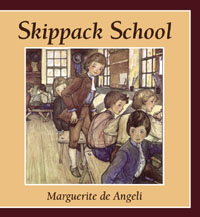 "Creak! Creak! The wheels of the cart groaned and squeaked as the wagon carried little Eli Shrawder and his family over the road through Philadelphia and the German Town to settle in a new home in Penn's Woods. The Shrawders had come from across the sea to make a new home in the Mennonite settlement on the Skippack. The first days there, with the neighbors gathered to help build their house, were exciting for Eli. And like most real boys he preferred to chase squirrels, go fishing, or work on the wooden bench he was carving for Mom than go to school. But with such a schoolmaster as Christopher Dock, he soon found himself wanting to learn his letters. How Eli planned a surprise for his schoolmates and won a prize from his schoolmaster is a story full of the fun, mischief and work of school days of any time. Around the real character of Christopher Dock, who has come down from the 1700's in the history of Skippack and Germantown as a beloved schoolmaster…Many of the places she describes in words and pictures may still be seen..."
"Creak! Creak! The wheels of the cart groaned and squeaked as the wagon carried little Eli Shrawder and his family over the road through Philadelphia and the German Town to settle in a new home in Penn's Woods. The Shrawders had come from across the sea to make a new home in the Mennonite settlement on the Skippack. The first days there, with the neighbors gathered to help build their house, were exciting for Eli. And like most real boys he preferred to chase squirrels, go fishing, or work on the wooden bench he was carving for Mom than go to school. But with such a schoolmaster as Christopher Dock, he soon found himself wanting to learn his letters. How Eli planned a surprise for his schoolmates and won a prize from his schoolmaster is a story full of the fun, mischief and work of school days of any time. Around the real character of Christopher Dock, who has come down from the 1700's in the history of Skippack and Germantown as a beloved schoolmaster…Many of the places she describes in words and pictures may still be seen..."
The first schoolhouse in Skippack was a log cabin located on the 100 aces of land that Mathias Van Bebber deeded to the Mennonites of Skippack in 1717, intended for "educating the young and burying of the dead" as it was written. The schoolhouse was built in the woods across Meetinghouse Rd. from the Lower Skippack Mennonite cemetery. It may have been the first structure built on this land.
Born in the late 1690's, Christopher Dock emigrated in 1714 and arrived to Skippack about 1717, according to a 1993 article by past-historian Willoughby "Bill" Moyer. Dock taught here from about 1717 to 1771, except for a 10 year period when he left to try his hand at farming on his farm near Woxall. He was a highly respected schoolmaster at the Mennonite schoolhouses in Skippack and Philadelphia, alternating 3 days of teaching at each location.
When Dock first arrived to Skippack, it is thought that he might have first lived with Michael Ziegler, as they were already close friends from the Palatine of Germany. In 1722, Michael had purchased 50 acres from Gerhardt Clemens on the south side of Skippack Pike between Rt.113 and Cressman Rd. Michael Ziegler and Christopher Dock married sisters who were the daughters of Andrew Schrager, owner of the 100 acre farm on the north side of Skippack Pike. Ziegler purchased the Schrager farm, in 1727.
Along Lesher Rd., east side, there is the Yellis Kassel (Cassel) farm which borders the Skippack Creek. Here, along the Skippack, it is long said that Dock used to go to a placid pool at a bend in the creek. There was a rustic shelter at this pleasant setting where he used to go to meditate. According to historian Moyer, it is said that Dock stayed here, on Kassel's nearby farm, during the three days he taught school in Skippack.
Christopher Dock was God-fearing, deeply religious and loved children. He would pray in his school. He had great insight into the teaching of children, for their obedience, respect and manners. One day in 1771, after teaching a class, Christopher Dock passed away. He was in the schoolhouse, "found on his knees in a position of prayer with his roll book open before him." (Boswell, 5)
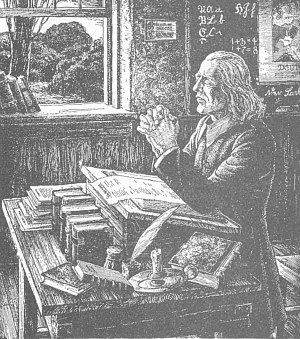
Drawing by Oliver W. Shenk in 1933 of Christopher Dock in Prayer.
Dock authored a book on etiquette called "A Hundred Rules of Conduct for Children", and another on pedagogy, said to be the first book of teaching in the colonies. He was very modest, not wanting attention or special treatment above others. "He would not permit his friend and publisher, Christopher Saur of Germantown, to publish his works while he was alive." He did not want notoriety to come from such a publication. (ibid)
Children in the area were taught by Christopher Dock, whose methods of teaching and discipline far preceded his time.
Excerpts from his children's book of etiquette:
"Do not talk during the sermon, and if others talk to you, do not answer. If you are sleepy, stand up a little while and try to keep it off."
"Toward your fellows act lovingly and peacefully; do not quarrel with them, hit them, dirty their clothes with your shoes or ink, nor give them nicknames. Act toward them always as you would have them act towards you."
"Do not gnaw bones with your teeth, neither make a noise trying to knock the marrow out of them."
(Goschenhoppen, 3)
Pennsylvania Governors Martin G. Brumbaugh and Samuel Pennypacker published biographies of this famous teacher. They were instrumental in causing a permanent memorial to be placed in his honor." It is located along the western wall of the Lower Skippack Mennonite cemetery. (Boswell, pgs 5,7)
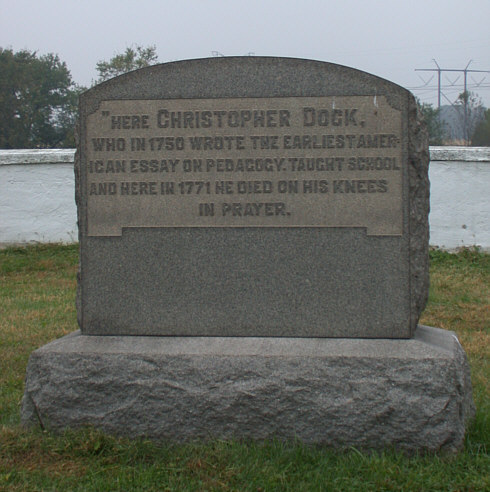
Memorial for Christopher Dock at the Lower Skippack Mennonite Church Cemetery
The author Marguerite De Angeli published the book "Skippack School", in 1939, which is written around schoolmaster Dock. The respected, private Christopher Dock High School, in nearby Towamencin, bears his name.
Christopher Dock's daughter Catherine married Peter Jansen (Johnson), first cousin of Walter Jansen. Walter was appointed the local census taker by the provisional government, taking the area's first census in 1756. Walter lived at the NE corner of Skippack Pike & Rt.113. He had a farm there from 1745-1794; the barn is yet standing. 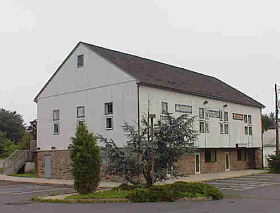 During this period, Christopher Dock owned a farm near Woxall, northwest of Rt.113 (which was laid out about 1726). For over 25 years, schoolmaster Dock road his horse passed Walter's farm, traveling between his own farm near Woxall and the schoolhouse at the Lower Skippack Mennonite church. The site's barn of Walter Johnson stands today (demolished in 2003 for a new Wawa Convenience Store) as the only representation in Skippack as a structure likely visited by Christopher Dock, other than the barn at the SW corner.
During this period, Christopher Dock owned a farm near Woxall, northwest of Rt.113 (which was laid out about 1726). For over 25 years, schoolmaster Dock road his horse passed Walter's farm, traveling between his own farm near Woxall and the schoolhouse at the Lower Skippack Mennonite church. The site's barn of Walter Johnson stands today (demolished in 2003 for a new Wawa Convenience Store) as the only representation in Skippack as a structure likely visited by Christopher Dock, other than the barn at the SW corner.
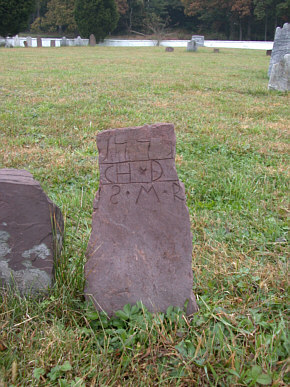 Christopher Dock's grave marker is a simple stone located in the Lower Skippack Mennonite Church grave yard with his initials "CH D" and the date of his death 1771 scratched into the stone.
Christopher Dock's grave marker is a simple stone located in the Lower Skippack Mennonite Church grave yard with his initials "CH D" and the date of his death 1771 scratched into the stone.
This web site was designed and donated by Lederach Associates Architect + Engineers.